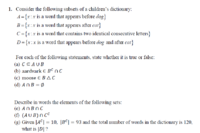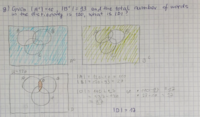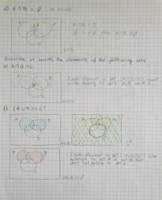You are using an out of date browser. It may not display this or other websites correctly.
You should upgrade or use an alternative browser.
You should upgrade or use an alternative browser.
Set theory
- Thread starter TinaW
- Start date
Dr.Peterson
Elite Member
- Joined
- Nov 12, 2017
- Messages
- 16,092
(a) You didn't use the specific definitions of the sets. This is not a generic question about any three sets.
(b) Your explanation is missing something.
(c) Okay
(d) You're probably right, but if I were required to base my answer only on what we are explicitly told, I might say "insufficient data". I could say the same about (b) and (c), since we aren't told that "aardvark" is in the dictionary ...
(e, f) I think you are supposed to explain in terms of the dictionary and the definitions you were given: "words that ..."
(g) Your reasoning is not stated fully, but you are right.
(b) Your explanation is missing something.
(c) Okay
(d) You're probably right, but if I were required to base my answer only on what we are explicitly told, I might say "insufficient data". I could say the same about (b) and (c), since we aren't told that "aardvark" is in the dictionary ...
(e, f) I think you are supposed to explain in terms of the dictionary and the definitions you were given: "words that ..."
(g) Your reasoning is not stated fully, but you are right.
(a) You didn't use the specific definitions of the sets. This is not a generic question about any three sets.
(b) Your explanation is missing something.
(c) Okay
(d) You're probably right, but if I were required to base my answer only on what we are explicitly told, I might say "insufficient data". I could say the same about (b) and (c), since we aren't told that "aardvark" is in the dictionary ...
(e, f) I think you are supposed to explain in terms of the dictionary and the definitions you were given: "words that ..."
(g) Your reasoning is not stated fully, but you are right.
In questions a)b)c)d) We were only supposed to state whether statement is true or false, explanations are there on my part only.
a) I explained why i think this statement is false (because of definitions of the sets..)
Dr.Peterson
Elite Member
- Joined
- Nov 12, 2017
- Messages
- 16,092
In questions a)b)c)d) We were only supposed to state whether statement is true or false, explanations are there on my part only.
a) I explained why i think this statement is false (because of definitions of the sets..)
No, (a) is true! THINK! What is the union of A and B, actually, in this specific case?
You reasoned from your Venn diagram, which doesn't reflect the reality of these sets.
Union of A and B are all the words that appear before the dog, and all the words that appear after the cat. C are all the words that have two identical consecutive letters.
Question: is a C subset of union of A and B?
A set is a subset of a set if all of its members are also members of superset. Because not all words that have two identical consecutive letters also go before dog and after cat, so that statement is false. I could be wrong, but im pretty sure its false.
Question: is a C subset of union of A and B?
A set is a subset of a set if all of its members are also members of superset. Because not all words that have two identical consecutive letters also go before dog and after cat, so that statement is false. I could be wrong, but im pretty sure its false.
pka
Elite Member
- Joined
- Jan 29, 2005
- Messages
- 11,971
a) In any dictionary, every word is either before dog or after cat.
b) The word aardvark is not after cat and has a double letter.
c) the set \(B\Delta C\) is call a symmetric difference and equals \((B\cap C^c)\cup(C\cap B^c)\).
d) The word cow \(\in A\cap B\)
b) The word aardvark is not after cat and has a double letter.
c) the set \(B\Delta C\) is call a symmetric difference and equals \((B\cap C^c)\cup(C\cap B^c)\).
d) The word cow \(\in A\cap B\)
Dr.Peterson
Elite Member
- Joined
- Nov 12, 2017
- Messages
- 16,092
As pka pointed out, A∪B consists of all words that are either before dog or after cat, which is the entire dictionary. If a word is not before dog, it is after cat. So any subset of the dictionary, such as C, is a subset of A∪B.Union of A and B are all the words that appear before the dog, and all the words that appear after the cat. C are all the words that have two identical consecutive letters.
Question: is a C subset of union of A and B?
A set is a subset of a set if all of its members are also members of superset. Because not all words that have two identical consecutive letters also go before dog and after cat, so that statement is false. I could be wrong, but im pretty sure its false.
In your (correct) Venn diagram, the bottom part (C only) is empty. The Venn diagram doesn't show this (unless you mark it to show such facts).
The error in your statement is "go before dog and after cat". That would be the intersection, not the union. Your first paragraph had it right, so I'm not sure where your thinking went wrong; but it is common to get confused over "and", forgetting that while the union consists of all elements of A and all elements of B, combined, each individual element of the union is in either A or B (or both), not in both A and B.
pka
Elite Member
- Joined
- Jan 29, 2005
- Messages
- 11,971
You have told twice that \(A\cup B\) is the set of all words in the dictionary.Union of A and B are all the words that appear before the dog, and all the words that appear after the cat. C are all the words that have two identical consecutive letters. Question: is a C subset of union of A and B?
A set is a subset of a set if all of its members are also members of superset. Because not all words that have two identical consecutive letters also go before dog and after cat, so that statement is false. I could be wrong, but im pretty sure its false.
Consider the mathematical equivalent: \((-\infty,1)\cup(-1,\infty)\equiv\mathbb{R}\).
That is to say that every real number \(x\) is grater that \(-1\) or less than \(1\).
Here is another observation: \(D=A\cap B\). like \((-\infty,1)\cap(-1,\infty)=(-1,1)\).




